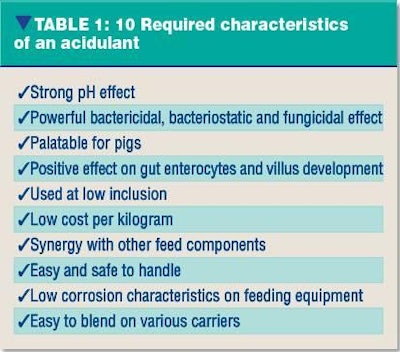
Herd management and organic acids are coming together to solve the problem of the young pig after weaning. Still immature from a physiological and immunological perspective, this weaned piglet is at risk. It has a depleted ability to generate sufficient hydrochloric acid to keep the pH low in the stomach and very limited mucosal protection immunity throughout the whole gut.
Whatever the quality of the energy/protein package used in its feed programme, the villi lining the digestive tract may be damaged and pathogens such as the coliforms and salmonella may colonise and replicate. The general result is likely to be diarrhoea, high mortality/morbidity and a powerful negative effect on post-weaning performance. In addition there is the aspect of food safety for the consuming human population if salmonella and campylobacter species replicate in this way.
Going back to the start of this sequence of events, there are 2 key factors that we can control; the first is the weaning age of the pig. The European Union has declared that piglets should not be weaned at less than 28 days of age unless there is a veterinary or welfare reason to do otherwise. Many farms now follow this edict, although the actual age at weaning will vary week on week in practice as the production cycles roll through. This gives the advantage that instead of weaning a piglet at 6.5-7kg which is immature, we have the potential for a stronger pig when weaned at 8-8.5kg. Its enzyme system will have advanced in the final week before weaning and its mucosal immunity is also generating more rapid and stronger responses.
Second, we can resolve the acid deficiency problem in the young animal. It simply means using organic acids, such as in the post-weaning feed programme. Simple organic blends have been used for some years in this way, both in weaner diets and in growing-finishing feed.
Through our own research and development programme at Provimi we are taking an ongoing look at acids. Various acidulants could be utilised. Each one of them provides different characteristics. From our work, we would define an ideal organic acid for pigs as including the properties set out in the accompanying Table 1.
But 10 points are listed and it is obvious that no single organic acid will deliver all of them. Some do come close, especially citric and sorbic acids, although sorbic acid falls short in terms of price per kilogram. Butyric acid and butyrate compounds also score points for the ability to stimulate enterocyte growth. Their difficulty relates to handling characteristics because they are volatile and the associated odours are not pleasant (for humans). A further disadvantage in some cases is that they are liquid in the acid form and so may be not suitable for including in meal or pellets for dry feeding.
In practice, therefore, the answer is to pool together various organic acids so their combined characteristics give acidification products that are targeted towards our various needs. Some acidulant blends are designed for post-weaned piglets as in-feed inclusions to give maximum power in terms of bactericidal and bacteriostatic effects. Palatability is also important with these products. Others for growing-finishing pigs might be simpler and cheaper where palatability is less critical.
Specific blends have been developed to curb the growth of salmonella bacteria. In Europe they have become of particular interest because of the major focus on reducing salmonella contamination right across the food chain.
Where Table 1 refers to good acid blend having a synergy with other feed components', note from our own commercial research that some acids can have effects on bacterial cell functions and these allow other elements to kill the cell more easily. Cell wall permeability can be affected by certain organic acids. There are also some acid ions which, on diffusing into the cells, will interfere with bacterial cell mitochondrial functions.
This has the effect of weakening the cell itself. When some essential oil compounds are applied concurrently, we see a powerful synergistic effect to kill many serotypes of bacteria. PIGI





.jpg?auto=format%2Ccompress&fit=crop&h=167&q=70&w=250)











